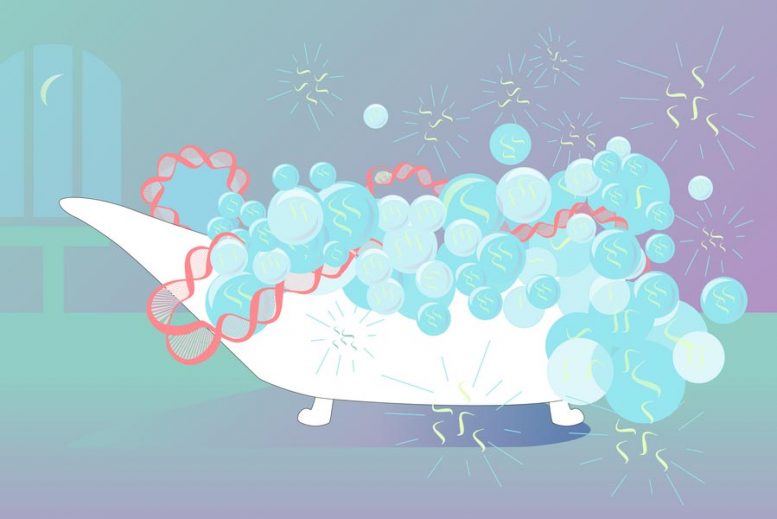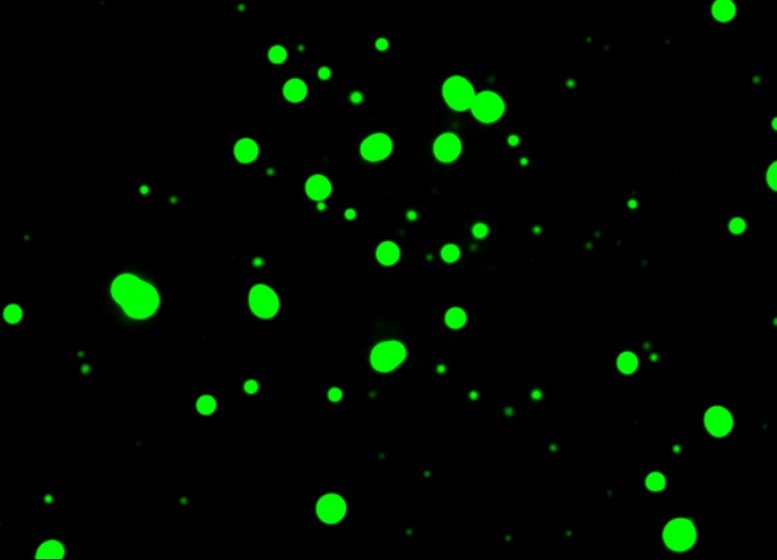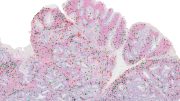
A collaboration between biologists and physicists suggests that RNA is a feedback regulator of its own production. Low concentrations of RNA lead to the formation of transcriptional condensates (represented here as bubbles), and high levels lead to the dissolution of those condensates. Credit: Jennifer Cook-Chrysos/Whitehead Institute
Research suggests the products of transcription — RNA molecules — regulate their own production through a feedback loop.
At any given moment in the human body, in about 30 trillion cells, DNA is being “read” into molecules of messenger RNA, the intermediary step between DNA and proteins, in a process called transcription.
Scientists have a pretty good idea of how transcription gets started: Proteins called RNA polymerases are recruited to specific regions of the DNA molecules and begin skimming their way down the strand, synthesizing mRNA molecules as they go. But part of this process is less well understood: How does the cell know when to stop transcribing?
Now, new work from the labs of Richard Young, Whitehead Institute for Biomedical Research member and MIT professor of biology, and Arup K. Chakraborty, professor of chemical engineering, physics, and chemistry at MIT, suggests that RNA molecules themselves are responsible for regulating their formation through a feedback loop. Too few RNA molecules, and the cell initiates transcription to create more. Then, at a certain threshold, too many RNA molecules cause transcription to draw to a halt.
The research, published in Cell, represents a collaboration between biologists and physicists, and provides some insight into the potential roles of the thousands of RNAs that are not translated into any proteins, called noncoding RNAs, which are common in mammals and have mystified scientists for decades.

Researchers formed these droplets in the lab to investigate the role of RNA in their formation and dissolution. Credit: Jon Henninger
A question of condensates
Previous work in Young’s lab has focused on transcriptional condensates, small cellular droplets that bring together the molecules needed to transcribe DNA to RNA. Scientists in the lab discovered the transcriptional droplets in 2018, noticing that they typically formed when transcription began and dissolved a few seconds or minutes later, when the process was finished.
The researchers wondered if the force that governed the dissolution of the transcriptional condensates could be related to the chemical properties of the RNA they produced — specifically, its highly negative charge. If this were the case, it would be the latest example of cellular processes being regulated via a feedback mechanism — an elegant, efficient system used in the cell to control biological functions such as red blood cell production and DNA repair.
As an initial test, the researchers used an in vitro experiment to test whether the amount of RNA had an effect on condensate formation. They found that within the range of physiological levels observed in cells, low levels of RNA encouraged droplet formation and high levels of RNA discouraged it.
Thinking outside the biology box
With these results in mind, Young lab postdocs and co-first authors Ozgur Oksuz and Jon Henninger teamed up with physicist and co-first author Krishna Shrinivas, a graduate student in Arup Chakraborty’s lab, to investigate what physical forces were at play.
Shrinivas proposed that the team build a computational model to study the physical and chemical interactions between actively transcribed RNA and condensates formed by transcriptional proteins. The goal of the model was not to simply reproduce existing results, but to create a platform with which to test a variety of situations.
“The way most people study these kinds of problems is to take mixtures of molecules in a test tube, shake it, and see what happens,” Shrinivas says. “That is as far away from what happens in a cell as one can imagine. Our thought was, ‘Can we try to study this problem in its biological context, which is this out-of-equilibrium, complex process?’”
Studying the problem from a physics perspective allowed the researchers to take a step back from traditional biology methods. “As a biologist, it’s difficult to come up with new hypotheses, new approaches to understanding how things work from available data,” Henninger says. “You can do screens, you can identify new players, new proteins, new RNAs that may be involved in a process, but you’re still limited by our classical understanding of how all these things interact. Whereas when talking with a physicist, you’re in this theoretical space extending beyond what the data can currently give you. Physicists love to think about how something would behave, given certain parameters.”
Once the model was complete, the researchers could ask it questions about situations that may arise in cells — for instance, what happens to condensates when RNAs of different lengths are produced at different rates as time ensues? — and then follow it up with an experiment at the lab bench. “We ended up with a very nice convergence of model and experiment,” Henninger says. “To me, it’s like the model helps distill the simplest features of this type of system, and then you can do more predictive experiments in cells to see if it fits that model.”
The charge is in charge
Through a series of modeling and experiments at the lab bench, the researchers were able to confirm their hypothesis that the effect of RNA on transcription is due to RNAs molecules’ highly negative charge. Furthermore, it was predicted that initial low levels of RNA enhance and subsequent higher levels dissolve condensates formed by transcriptional proteins. Because the charge is carried by the RNAs’ phosphate backbone, the effective charge of a given RNA molecule is directly proportional to its length.
In order to test this finding in a living cell, the researchers engineered mouse embryonic stem cells to have glowing condensates, then treated them with a chemical to disrupt the elongation phase of transcription. Consistent with the model’s predictions, the resulting dearth of condensate-dissolving RNA molecules increased the size and lifetime of condensates in the cell. Conversely, when the researchers engineered cells to induce the production of extra RNAs, transcriptional condensates at these sites dissolved. “These results highlight the importance of understanding how non-equilibrium feedback mechanisms regulate the functions of the biomolecular condensates present in cells”, says Chakraborty.
Confirmation of this feedback mechanism might help answer a longstanding mystery of the mammalian genome: the purpose of non-coding RNAs, which make up a large portion of genetic material. “While we know a lot about how proteins work, there are tens of thousands of noncoding RNA species, and we don’t know the functions of most of these molecules,” says Young. “The finding that RNA molecules can regulate transcriptional condensates makes us wonder if many of the noncoding species just function locally to tune gene expression throughout the genome. Then this giant mystery of what all these RNAs do has a potential solution.”
The researchers are optimistic that understanding this new role for RNA in the cell could inform therapies for a wide range of diseases. “Some diseases are actually caused by increased or decreased expression of a single gene,” says Oksuz, a co-first author. “We now know that if you modulate the levels of RNA, you have a predictable effect on condensates. So you could hypothetically tune up or down the expression of a disease gene to restore the expression — and possibly restore the phenotype — that you want, in order to treat a disease.”
Young adds that a deeper understanding of RNA behavior could inform therapeutics more generally. In the past 10 years, a variety of drugs have been developed that directly target RNA successfully. “RNA is an important target,” Young says. “Understanding mechanistically how RNA molecules regulate gene expression bridges the gap between gene dysregulation in disease and new therapeutic approaches that target RNA.”
Reference: “RNA-Mediated Feedback Control of Transcriptional Condensates” by Jonathan E. Henninger, Ozgur Oksuz, Krishna Shrinivas, Ido Sagi, Gary LeRoy, Ming M. Zheng, J. Owen Andrews, Alicia V. Zamudio, Charalampos Lazaris, Nancy M. Hannett, Tong Ihn Lee, Phillip A. Sharp, Ibrahim I. Cissé, Arup K. Chakraborty and Richard A. Young, 16 December 2020, Cell.
DOI: 10.1016/j.cell.2020.11.030









Be the first to comment on "RNA Molecules Are Masters of Their Own Destiny – Regulating Their Own Production Through a Feedback Loop"